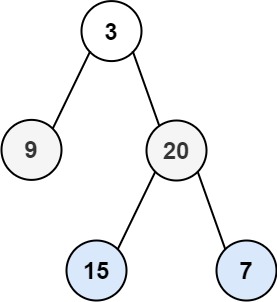Class Solution
Medium
Given the root of a binary tree, return the level order traversal of its nodes’ values. (i.e., from left to right, level by level).
Example 1:

Input: root = [3,9,20,null,null,15,7]
Output: [[3],[9,20],[15,7]]
Example 2:
Input: root = [1]
Output: 1
Example 3:
Input: root = []
Output: []
Constraints:
- The number of nodes in the tree is in the range
[0, 2000]. -1000 <= Node.val <= 1000
To solve the “Binary Tree Level Order Traversal” problem in Java with a Solution class, we’ll perform a breadth-first search (BFS) traversal of the binary tree. Below are the steps:
-
Create a
Solutionclass: Define a class namedSolutionto encapsulate our solution methods. -
Create a
levelOrdermethod: This method takes the root node of the binary tree as input and returns the level order traversal of its nodes’ values. -
Initialize a queue: Create a queue to store the nodes during BFS traversal.
-
Check for null root: Check if the root is null. If it is, return an empty list.
-
Perform BFS traversal: Enqueue the root node into the queue. While the queue is not empty:
- Dequeue the front node from the queue.
- Add the value of the dequeued node to the current level list.
- Enqueue the left and right children of the dequeued node if they exist.
- Move to the next level when all nodes in the current level are processed.
-
Return the result: After the BFS traversal is complete, return the list containing the level order traversal of the binary tree.
Here’s the Java implementation:
import java.util.ArrayList;
import java.util.LinkedList;
import java.util.List;
import java.util.Queue;
class Solution {
public List<List<Integer>> levelOrder(TreeNode root) {
List<List<Integer>> result = new ArrayList<>(); // Initialize list to store level order traversal
if (root == null) return result; // Check for empty tree
Queue<TreeNode> queue = new LinkedList<>(); // Initialize queue for BFS traversal
queue.offer(root); // Enqueue the root node
while (!queue.isEmpty()) {
int levelSize = queue.size(); // Get the number of nodes in the current level
List<Integer> level = new ArrayList<>(); // Initialize list for the current level
for (int i = 0; i < levelSize; i++) {
TreeNode node = queue.poll(); // Dequeue the front node
level.add(node.val); // Add node value to the current level list
// Enqueue the left and right children if they exist
if (node.left != null) queue.offer(node.left);
if (node.right != null) queue.offer(node.right);
}
result.add(level); // Add the current level list to the result list
}
return result; // Return the level order traversal
}
// Definition for a TreeNode
public class TreeNode {
int val;
TreeNode left;
TreeNode right;
TreeNode() {}
TreeNode(int val) { this.val = val; }
TreeNode(int val, TreeNode left, TreeNode right) {
this.val = val;
this.left = left;
this.right = right;
}
}
}
This implementation follows the steps outlined above and efficiently computes the level order traversal of the binary tree in Java using BFS.
-
Constructor Summary
Constructors -
Method Summary
-
Constructor Details
-
Solution
public Solution()
-
-
Method Details
-
levelOrder
-